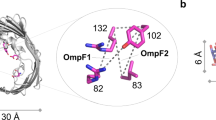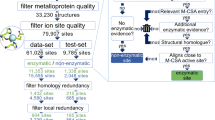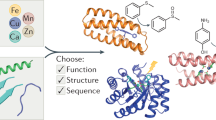Abstract
Activation of protein function through phosphorylation can be mimicked by the engineering of specific metal binding sites. The addition of two histidine residues to glycogen phosphorylase allows enzymatic activation by transition metals in a cooperative and allosteric manner. Crystal structures of the metallo-enzyme have been determined and show that the structural transition induced upon metal binding (Ni2+) is, in part, analogous to the mode of activation of the native enzyme. The designed metal activation site allows assignment of the structural changes which trigger activation in this allosteric enzyme and, further, provide insight into the evolutionary development of multiple activation sites.
This is a preview of subscription content, access via your institution
Access options
Subscribe to this journal
Receive 12 print issues and online access
$259.00 per year
only $21.58 per issue
Buy this article
- Purchase on SpringerLink
- Instant access to full article PDF
Prices may be subject to local taxes which are calculated during checkout
Similar content being viewed by others
References
Nishizuka, Y. Signal transduction crosstalk. Trends biochem. Sci. 17, 367 (1992).
Cohen, P. The structure and regulation of protein phosphatases. A. Rev. Biochem. 58, 453–508 (1989).
Hers, H.G. Mechanisms of blood glucose homeostasis. J. inherit. metab. Dis. 13, 395–410 (1990).
Johnson, L.N. Glycogen phosphorylase; control by phosphorylation and allosteric effectors. FASEB J. 6, 2274–2282 (1992).
Browner, M.F. & Fletterick, R.J. Phosphorylase: a biological transducer. Trends biochem. Sci. 17, 66–71 (1992).
Barford, D., Hu, S.-H. & Johnson, L.N. Structural mechanism for glycogen phosphorylase control by phosphorylation and AMR. J. molec. Biol. 218, 233–260 (1991).
Goldsmith, E.J., Sprang, S.R., Hamlin, R., Xuong, N.-H. & Fletterick, R.J. Domain separation in the activation of glycogen phosphorylase a. Science 245, 528–532 (1989).
Sprang, S., Goldsmith, E. & Fletterick, R. Structure of the nucleotide activation switch in glycogen phosphorylase a. Science 237, 1012–1019 (1987).
Sprang, S.R. et al. Structural changes in glycogen phosphorylase induced by phsophorylation. Nature 336, 215–221 (1988).
Sprang, S.R., Withers, S.G., Goldsmith, E.J., Fletterick, R.J. & Madsen, N.B. The structrual basis the activation of glycogen phosphorylase b by adenosine monophosphate. Science 254, 1367–1371 (1991).
Browner, M.F., Hwang, P.K. & Fletterick, R.J. Cooperative binding is not required for activation of muscle phosphorylase. Biochemistry 31, 11291–11296(1992).
Glusker, J.P. Structural aspects of metal ligandingto functional groups in proteins Adv. prot. Chem. 42 1–76 (1991)
McGrath, M.E., Haymore, B.L., Summers, N.L., Craik, C.S. & Fletterick, R.J. Structure of an engineered metal-activated switch in trypsin. Biochemistry 32, 1914–1919 (1993).
Higaki, J.N., Haymore, B.L., Chen, S., Fletterick, R.J. & Craik, C.S. Regulation of serine protease activity by an engineered metal switch. Biochemistry 29, 8582–8586(1990).
Arnold, F.H. & Haymore, B.L. Engineered metal-binding proteins: purification to protein folding. Science 252, 1796–1797 (1991).
Iverson, B.L. et al. Metalloantibodies. Science 249, 659–662 (1990).
Roberts, V.A. et al. Antibody remodeling: A general solution to the design of a metal-coordination site in an antibody binding pocket. Proc. natn. Acad. Sci. U.S.A. 87, 6654–6658 (1990).
Cuenoud, B. & Schepartz, A. Altered specificity of DNA-binding protein with transtion metal dimerization domains. Science 259, 510–513 (1993).
Handel, T.M., Williams, S.A. & DeGrado, W.F. Metal ion-dependent modulation of the dynamics of a designed protein. Science 261, 879–885(1993).
Sprang, S., Goldsmith, E. & Fletterick, R. The crystal structure of glucose-inhibited rabbit muscle glycogen phosphorylase a at 2.1 Å resolution. J. molec. Biol. (In the press).
Baron, C., Gonzalez, J.F., Mateo, P.L. & Cortijo, M. Thermodynamic analysis of the activation of glycogen phosphorylase b over a range of temperatures. J. biol. Chem. 264, 12872–12878 (1989).
Ralston, D.M. & O'Halloran, T.V. Ultrasensitivity and heavy-metal selectivity of the allosterically modulated MerR transcription complex. Proc. natn. Acad. Sci. U.S.A. 87, 3846–3850. (1990).
Hellinga, H.W. & Richards, F.M. Construction of new ligand binding sites in proteins of known structure I. Computer-aided modelling of sites with pre-defined geometry. J. molec. Biol. 222, 763–785 (1991).
Koshland, D.E., Nemethy, G. & Filmer, D. Comparison of experimental binding data and theoretical models in proteins containing subunits. Biochemistry 5, 365 (1966).
Monod, J., Wyman, J. & Changeux, J.-P. On the nature of allosteric transitions: A plausible model. J. molec. Biol. 12, 88–118 (1965).
Martin, J.L., Johnson, L.N. & Withers, S.G. Comparison of the binding of glucose and glucose 1-phosphate derivatives to the T-state glycogen phosphorylase b. Biochemistry 29, 10745–10757 (1990).
Barford, D. & Johnson, L.N. The allosteric transition of glycogen phosphorylase. Nature 340, 609–616 (1989).
Browner, M.F., Fauman, E.B. & Fletterick, R.J. Tracking conformational states in allosteric transitions of phosphorylase. Biochemistry 31, 11297–11304 (1992).
Browner, M.F., Rasor, P., Tugendreich, S. & Fletterick, R.J. Temperature-sensitive production of rabbit muscle glycogen phosphorylase in Escherichia coli. Prot. Engng. 4, 351–357 (1991).
Luong, C.B.H., Browner, M.F. & Fletterick, R.J. Purification of glycogen phosphorylase isozymes by metal-affinity chromatography. J. Chromat. 584, 77–84 (1992).
Cori, C.F., Cori, G.T. & Green, A.A. Crystalline muscle phosphrylase III. Kinetics. J. biol. Chem. 135, 39–46 (1943).
Madsen, N.B., Avramovic-Zikic, O. Lue, P.F. & Honikel, K.O. Studies on allosteric phenomena in glycogen phosphorylase b. Molec. Cell. Biochem. 11, 35–50 (1976).
Eagles, P.A.M., Iqbal, M., Johnson, L.N., Mosley, J. & Wilson, K.S. A tetragonal crystal form of phosphorylase b. J. molec. Biol. 71, 803–806 (1972).
Brunger, A.T. Crystallographic R-factor refinement by molecular dyanmics. Science 235, 458–460 (1987).
Jones, T.A. Interactive computer graphics: FRODO. J. appl. Crystallogr. 11, 268–272 (1978).
Kabsch, W. Evaluation of single crystal X-ray diffraction data from a position sensitive detector. J. appl. Crystallogr. 21, 916–924 (1988).
Author information
Authors and Affiliations
Rights and permissions
About this article
Cite this article
Browner, M., Hackos, D. & Fletterick, R. Identification of the molecular trigger for allosteric activation in glycogen phosphorylase. Nat Struct Mol Biol 1, 327–333 (1994). https://doi.org/10.1038/nsb0594-327
Received:
Accepted:
Issue date:
DOI: https://doi.org/10.1038/nsb0594-327
This article is cited by
-
Computational protein engineering
Nature Structural Biology (1998)
-
When one and one are not two
Nature Structural & Molecular Biology (1995)



